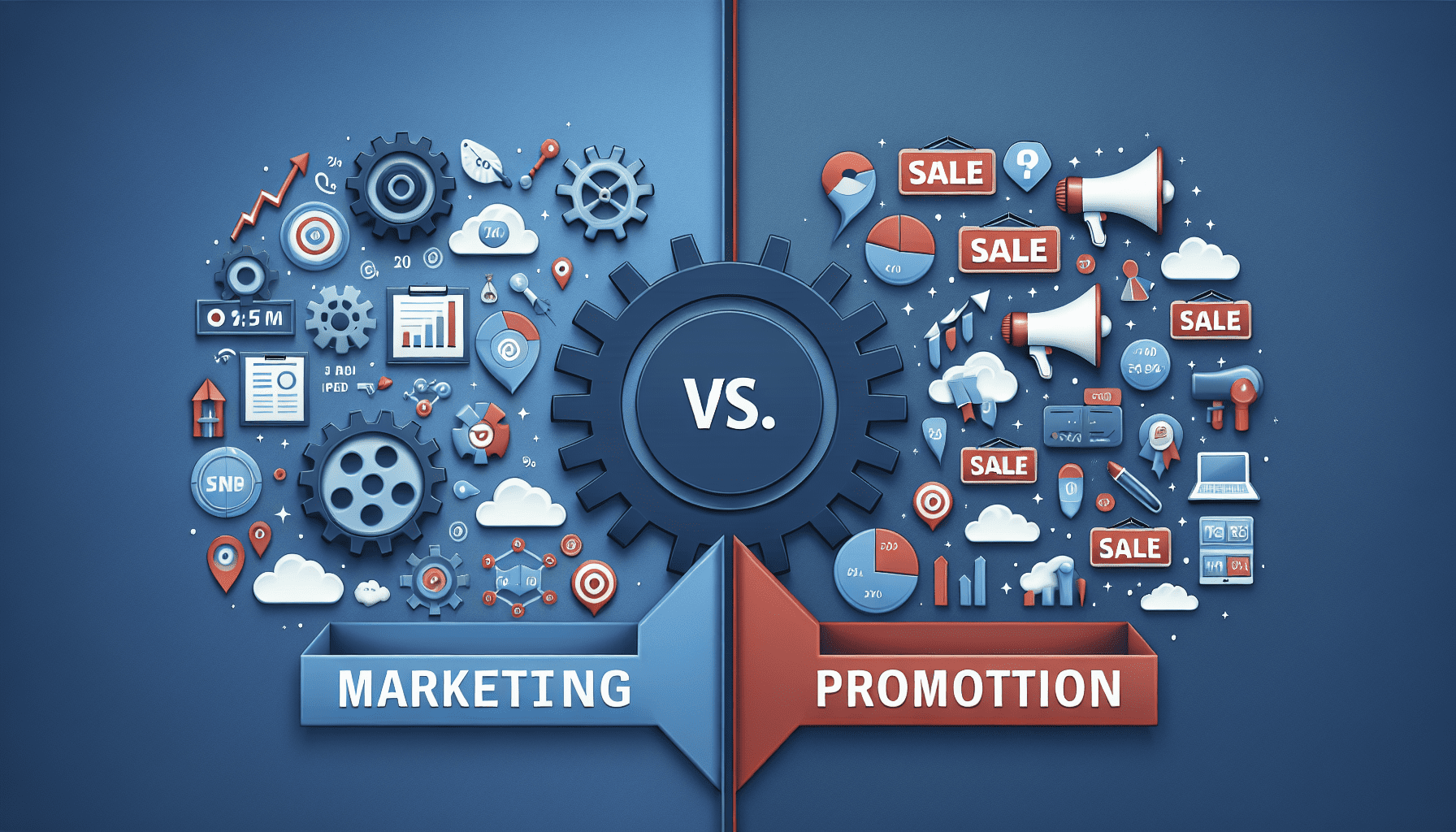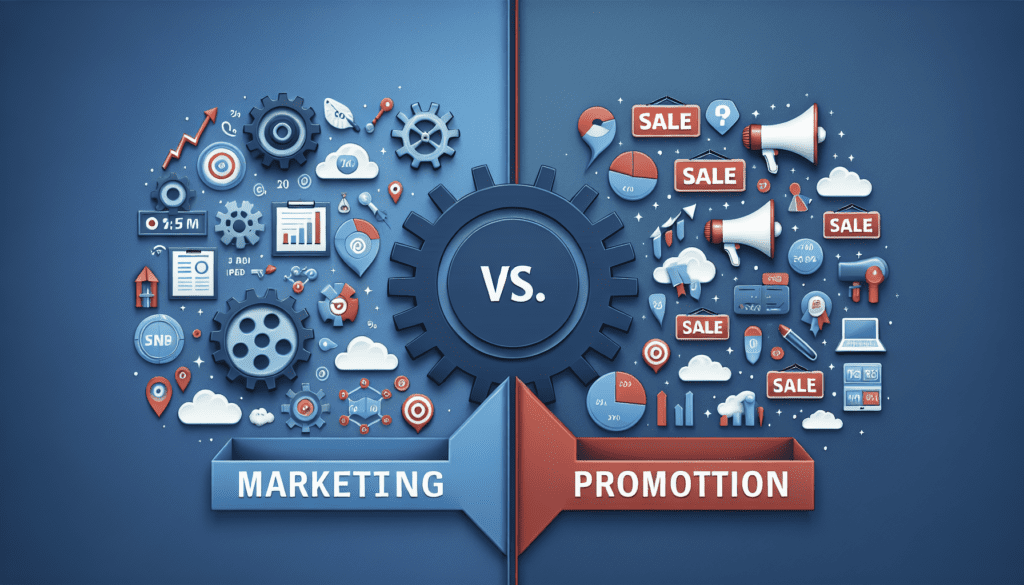
Introduction
Marketing and promotion are essential components of a successful business strategy, but they serve different purposes and impact your business in distinct ways. Understanding the nuances between marketing and promotion can significantly enhance how you reach your target audience, allocate resources, and achieve your business objectives. Whether you’re launching a new product, entering a new market, or looking to strengthen your brand, recognizing the roles of marketing and promotion can lead to more informed decisions and better strategic planning.
Understanding Marketing and Promotion
Defining Marketing
Marketing is a broad, strategic function encompassing profitably identifying, anticipating, and satisfying customer requirements. It involves researching the market, understanding consumer behavior, and developing a product or service that meets their needs. Marketing is an integrated process through which companies build strong customer relationships and create value for their customers and themselves. Understanding consumer desires and needs is crucial to creating products that meet them through design, pricing, distribution, and service.
Defining Promotion
Promotion, on the other hand, is a component of marketing that explicitly focuses on creating awareness of a product, service, or brand. It aims to increase visibility, interest, and sales through various strategies and media. Promotion involves multiple activities, including advertising, sales promotions, public relations, direct marketing, and personal selling. Each activity is geared towards communicating with target audiences to inform them of the company’s offerings and persuade them to purchase.
Key Differences Between Marketing and Promotion
Goals of Marketing
The primary goal of marketing is to generate long-term consumer commitment and build brand loyalty. It focuses on creating a comprehensive understanding of the market and its dynamics and strategically positioning the product or service to fulfill the customers’ evolving needs. The objectives often include:
– Building a solid brand identity
– Developing lasting relationships with customers
– Increasing overall sales and market share
– Ensuring customer satisfaction and loyalty
Marketing is about understanding the big picture of what customers want, the broad competitive landscape, and how a company can deliver better value than its competitors.
Goals of Promotion
In contrast, the goals of promotion are more immediate and sales-oriented. Promotional activities aim to:
– Boost the visibility of a product or service
– Encourage immediate sales or responses
– Inform or persuade potential customers
– Create a buzz or increase market excitement
Promotion is often more tactical, seeking quick returns through specific campaigns, and is usually the driving force behind short-term spikes in sales volume.
Tactics in Marketing vs. Promotion
When comparing the tactics used in marketing versus those used in promotion, several distinctions become clear. Marketing tactics encompass a wide array of activities that include, but are not limited to:
– Market research to gather and analyze data on customer preferences and trends.
– Product development tailored to meet market demands.
– Setting prices based on market analysis, cost, demand, and competition.
– Ensuring products are readily available to consumers through effective distribution channels is a crucial management aspect.
– Service and support to enhance customer satisfaction and retention.
Promotion-focused tactics are often more straightforward and can include:
– Advertising through various channels such as TV, radio, print, online, and outdoor.
– Sales promotions like discounts, coupons, contests, and free samples.
– Public relations efforts to enhance the public image and handle media communications.
– Direct marketing through emails, brochures, and direct mail.
– Personal selling, wherein sales representatives directly engage with prospects to close sales.
Understanding these differences between marketing and promotion helps illustrate why each plays a vital role in a business’s success. However, they serve distinct purposes and deliver additional value to the company.
Impact on Business Success
How Marketing Contributes to Business Success
Marketing is pivotal to business success, extending far beyond a mere spurt of promotions. It cultivates long-term relationships between your business and its customers, enhancing brand equity and establishing a consistent market presence. A sound marketing strategy involves an intricate understanding of your target audience, including their needs, preferences, and behaviors. By addressing these elements, businesses can create compelling value propositions and develop products or services that genuinely resonate with consumers. Effective marketing increases brand awareness and loyalty, which is crucial for sustainable growth and higher profit margins. Moreover, through strategic analysis, marketing helps companies adapt to changing market conditions and consumer trends, enabling them to stay relevant and competitive.
How Promotion Contributes to Business Success
In contrast, promotion directly impacts business performance by boosting the visibility of specific products or services and driving immediate sales. Promotional activities like sales discounts, coupons, and product launches create urgency and encourage consumer action. This surge in consumer engagement can lead to significant short-term revenue increases, which are vital for cash flow and funding ongoing operations. Furthermore, promotions can help introduce new products or reinvigorate interest in older offerings, contributing to a diversified product portfolio and broader market reach.
When to Focus on Marketing vs. Promotion

Factors to Consider
Deciding whether to focus on marketing or promotion involves several key factors. Consider the stage of your business—startups may rely more on promotion to generate buzz and initial sales. In contrast, established companies might benefit from deeper, more refined marketing strategies to expand their market share and customer loyalty. For high-ticket or niche items, use detailed educative marketing. Mass-market, fast-moving goods benefit from frequent and dynamic promotional campaigns. Lastly, the market environment should influence your approach; for example, intensive promotional tactics might be more effective during a highly competitive launch period or holiday season.
Finding the Right Balance
Striking the right balance between marketing and promotion is essential for optimized business performance. This balance can be achieved by setting clear objectives and understanding the strengths of each approach. For instance:
- Set strategic goals: Define what you aim to achieve in both the short-term and long-term run. Promotion might be the focus to accelerate quick wins, whereas marketing efforts are sustained to build future-proof business dynamics.
- Allocate budget wisely: Invest in marketing to build your brand while allocating funds for periodic promotions to boost sales volume when needed.
- Monitor and adjust: Continuously analyze the outcomes of both marketing and promotional strategies. Use data-driven insights to change tactics, ensuring that both areas contribute effectively to business goals.
By considering these factors and using a dynamic approach, businesses can consistently attract and engage customers, building a loyal customer base for long-term success. Combining marketing and promotional elements in a complementary fashion will maximize impact, driving immediate results and sustainable growth.
Case Studies: Successful Strategies

Understanding the practical application of marketing and promotion can clarify their distinct roles. Here, we examine some case studies of brands that have successfully harnessed the power of either marketing or promotion.
Brands that Emphasize Marketing
Apple stands as a prime example of effective marketing. Unlike companies that heavily push promotions, Apple focuses on creating a strong brand identity and customer connection. This strategy involves:
– Developing innovative products that promise high quality and unique design.
– Maintaining a consistent narrative that emphasizes simplicity and user-friendliness across all communications.
– Cultivating an aspirational image that makes customers feel a part of a premium community.
This marketing-led approach has enhanced Apple’s brand recall and enabled it to command higher prices than its competitors, proving that effective marketing can be a significant differentiator in the market.
Another example is Nike, which leverages storytelling to resonate deeply with its audience. Its marketing campaigns often highlight personal triumph and perseverance, creating an emotional connection with the brand. Nike has effectively ingrained its brand into the cultural fabric by consistently associating its products with high performance and personal achievement.
Brands that Excel in Promotion
In contrast, large retail chains like Walmart excel in promotion strategies. Walmart’s success is built on:
– Frequent discounts and time-sensitive deals that attract and retain a cost-conscious customer base.
– Extensive advertising campaigns that focus on price advantages and product variety.
– Strategic placement of in-store promotions to induce impulse purchases.
These promotional efforts are designed to drive immediate sales and boost short-term revenue, aligning with the company’s value-for-money image.
Similarly, fast food giant McDonald’s utilizes promotions to lure customers and encourage repeat visits. Examples include offering limited-time menus, meal deals, and famous campaigns like “Monopoly at McDonald’s,” which have successfully increased foot traffic and sales volumes during promotional periods. By consistently providing new reasons for customers to visit their restaurants, McDonald’s keeps its brand dynamic and top of mind among consumers.
Conclusion
While marketing and promotion are essential for business success, they serve distinctly different purposes. Marketing is a comprehensive process that includes market research, product development, branding, and customer relationship management. It is strategic, building a strong brand and a loyal customer base. On the other hand, promotion concentrates on increasing sales and is often tactical, involving specific strategies to boost immediate customer engagement. These can include discounts, special offers, and advertising campaigns.
Understanding the differences and functions of each can significantly assist businesses in crafting effective strategies. To achieve optimal results, businesses should integrate marketing and promotion to achieve sustainable growth and success. By doing so, companies can ensure they attract customers and nurture and retain them over time. A balanced approach that leverages the strengths of both marketing and promotion will usually be the most effective in achieving a business’s objectives.